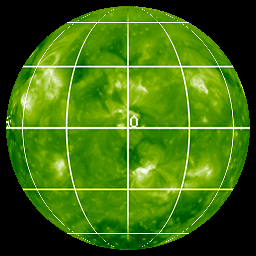On Feb. 6, NASA’s twin STEREO probes moved into position on opposite sides of the sun, and they now are beaming back uninterrupted images of the entire star — front and back.
”For the first time ever, we can watch solar activity in its full three-dimensional glory,” says Angelos Vourlidas, a member of the STEREO science team at the Naval Research Lab in Washington, D.C.
”This is a big moment in solar physics,” says Vourlidas. “STEREO has revealed the sun as it really is — a sphere of hot plasma and intricately woven magnetic fields.”
Read more about this story by logging into NEON, join the NASA Explorer Schools group, and find the “GENESIS: What Are We Made of? The Sun, Earth and You” forum. The complete write-up on this exciting new development is available in that forum.
 This movie shows a spherical map of the Sun, formed from a combination of STEREO Ahead and Behind beacon images, along with an SDO/AIA image in between. The movie starts with the view of the Sun as seen from Earth, with the 0 degree meridian line in the middle. The map then rotates through 360 degrees to show the part of the Sun not visible from Earth. The black wedge shows the part of the Sun not yet visible to the STEREO spacecraft.
This movie shows a spherical map of the Sun, formed from a combination of STEREO Ahead and Behind beacon images, along with an SDO/AIA image in between. The movie starts with the view of the Sun as seen from Earth, with the 0 degree meridian line in the middle. The map then rotates through 360 degrees to show the part of the Sun not visible from Earth. The black wedge shows the part of the Sun not yet visible to the STEREO spacecraft.For more information about the STEREO spacecraft, visit the mission website.

Hi everyone,
I would like to ask if it is possible, using the stereo mission spacecrafts, to measure the bending and perhaps the change in velocity of an electromagnetic signal from the crafts to the Earth while passing at different distances from the sun’s surface.
Greetings
Jordi
Hello,
My name is Paul Franmpton and I have a dire question that it seems no one can answer. My question is “can a sun be made of other elements other then hydrogen and helium?” Now the reason I am asking this is because we are learning about the sun in my astronomy class (here at West Johnston High School in Benson, NC) and from my understanding a sun can only be made with those two elements. Now think it is the most common elements in the KNOWN universe yes and it hard for us to say thinks about the unknown but somewhere maybe towards the center or outer edge of a galaxy could we not have a sun made of another element either a cold star or a star the is even hotter and/or brighter then are own sun. Could this also be a way to preform nuclear fusion in a safe and stable matter? That one question could answer all of these questions? Thank you for your time and attention.
Paul,
“Humans have the capacity to ask questions, but not all of our questions have meaningful answers, (Number of angels that can dance on a pin) even though they seem perfictly legit.
Astonomers have studied a lot of stars, even in distant galaxies, and in all cases, normal stars are dominated by hydrogen and helium to the tune of more than 95% of their mass. The rest is taken up by the other elements in the periodic table, but the exact amount differs according to the age of the star. The oldest stars we know about have less than 1% of their mass in these ‘heavy’ elements.
Now, there are ‘dead stars’ called white dwarfs and neutron stars, which we still call stars because they emit light by themselves, but not by thermonuclear means.They are just the hot, dense cores of stars that are cooling off and are still tens of thousands of degrees hot at their surface, so they emit light.
So, to answer your question, there are no known normal stars that are not almost entirely made of hydrogen and helium in our unverse. We can speculate about other universes but we have no way to know about them.
Hope this helps! Not many high school students I know would bother asking such an interesting question!
Dr. Sten Odenwald
NASA Research Astronomer